In an era riddled with economic turbulence, it is both telling and astonishing that American Express’s affluent cardmembers are continuing to indulge in lavish spending habits. Chief Financial Officer Christophe Le Caillec’s remarks to CNBC reveal a robust consumer confidence that many would argue stands in stark contrast to the overall malaise affecting the economy. As the company reported a 6% increase in billed business for the first quarter, adjusted for the previous year’s leap day, it’s clear that wealthier customers are not just surviving; they are thriving.
While the broader economic landscape remains fraught with challenges—most notably the looming threat of tariffs under President Trump—the spending behavior of American Express cardholders suggests a dichotomy: a resilient upper class insulated from the fears of recession. The unwavering spending is not merely a coincidence; it highlights an ever-growing divide between the affluent and the middle class, a factor that could have serious ramifications for the economy in the long run.
The Young and the Restless: A New Generation of Spenders
What is perhaps more intriguing is the uptick in spending driven by younger demographics such as Millennials and Gen Z. They’ve demonstrated a remarkable 14% increase in expenditures, eclipsing their Gen X and Baby Boomer counterparts, whose growth levels were markedly muted at 5% and 1%, respectively. This trend underscores a cultural shift in spending priorities, wherein younger individuals prioritize experiences and lifestyle choices over material possessions.
Yet, one can’t help but ponder the sustainability of this trend. Are these younger consumers genuinely buoyed by confidence, or are they racing to spend before their purchasing power erodes further due to impending tariffs? The intriguing comment by Le Caillec regarding the cautious behavior of older cardholders—many of whom are likely more acutely aware of economic recessions—adds a layer of apprehension about whether this youthful exuberance is genuinely reflective of underlying economic health.
Glimmers of Hope in the Restaurant Sector
Interestingly, Le Caillec cites an 8% increase in restaurant spending, which he emphasizes as an indicator of discretionary confidence. Unlike other purchases, dining out isn’t something consumers can easily “pull forward,” making this growth both comforting and enlightening. In a society where dining is increasingly viewed as both an experience and a social necessity, this spike may well signal that affluent consumers are not inclined to retreat from their lifestyles, despite external pressures.
However, it’s important to recognize the stark contrast in this buoyant restaurant spending with the stagnation in airline transactions, which have only risen by 3%. With a world still grappling with the aftershocks of the pandemic and its impact on travel, this sector appears to reflect more cautious consumer sentiment. It’s disconcerting that while some sectors flourish, others languish—an echo of a broader economic narrative where only the privileged continue their spending sprees, potentially sidelining the collective struggle of many.
The Tariff Conundrum: Business Sentiment Versus Consumer Action
Lastly, one cannot overlook the ominous cloud of tariffs that loom large on the economic horizon. While American Express seems confident in maintaining its revenue growth projections, the broader retail sector appears hesitant, with many companies retracting their earnings guidance. This divergence raises questions about whether American Express’s affluent cardmembers can uphold this extravagant spending pattern in the face of rising costs driven by potential tariffs.
Overall, while the prevailing sentiment among American Express cardholders suggests resilience and a robust economy for the affluent, the discomfiting truth is that beneath this gilded surface lies a concatenation of challenges that could fracture this confidence unexpectedly. In a way, it appears that the privileged are enjoying a party while others stand frozen in uncertainty. The question now becomes: how long can this disparity last before the tide turns?

